24.4: Community Relationships
- Page ID
- 17817
\( \newcommand{\vecs}[1]{\overset { \scriptstyle \rightharpoonup} {\mathbf{#1}} } \)
\( \newcommand{\vecd}[1]{\overset{-\!-\!\rightharpoonup}{\vphantom{a}\smash {#1}}} \)
\( \newcommand{\dsum}{\displaystyle\sum\limits} \)
\( \newcommand{\dint}{\displaystyle\int\limits} \)
\( \newcommand{\dlim}{\displaystyle\lim\limits} \)
\( \newcommand{\id}{\mathrm{id}}\) \( \newcommand{\Span}{\mathrm{span}}\)
( \newcommand{\kernel}{\mathrm{null}\,}\) \( \newcommand{\range}{\mathrm{range}\,}\)
\( \newcommand{\RealPart}{\mathrm{Re}}\) \( \newcommand{\ImaginaryPart}{\mathrm{Im}}\)
\( \newcommand{\Argument}{\mathrm{Arg}}\) \( \newcommand{\norm}[1]{\| #1 \|}\)
\( \newcommand{\inner}[2]{\langle #1, #2 \rangle}\)
\( \newcommand{\Span}{\mathrm{span}}\)
\( \newcommand{\id}{\mathrm{id}}\)
\( \newcommand{\Span}{\mathrm{span}}\)
\( \newcommand{\kernel}{\mathrm{null}\,}\)
\( \newcommand{\range}{\mathrm{range}\,}\)
\( \newcommand{\RealPart}{\mathrm{Re}}\)
\( \newcommand{\ImaginaryPart}{\mathrm{Im}}\)
\( \newcommand{\Argument}{\mathrm{Arg}}\)
\( \newcommand{\norm}[1]{\| #1 \|}\)
\( \newcommand{\inner}[2]{\langle #1, #2 \rangle}\)
\( \newcommand{\Span}{\mathrm{span}}\) \( \newcommand{\AA}{\unicode[.8,0]{x212B}}\)
\( \newcommand{\vectorA}[1]{\vec{#1}} % arrow\)
\( \newcommand{\vectorAt}[1]{\vec{\text{#1}}} % arrow\)
\( \newcommand{\vectorB}[1]{\overset { \scriptstyle \rightharpoonup} {\mathbf{#1}} } \)
\( \newcommand{\vectorC}[1]{\textbf{#1}} \)
\( \newcommand{\vectorD}[1]{\overrightarrow{#1}} \)
\( \newcommand{\vectorDt}[1]{\overrightarrow{\text{#1}}} \)
\( \newcommand{\vectE}[1]{\overset{-\!-\!\rightharpoonup}{\vphantom{a}\smash{\mathbf {#1}}}} \)
\( \newcommand{\vecs}[1]{\overset { \scriptstyle \rightharpoonup} {\mathbf{#1}} } \)
\( \newcommand{\vecd}[1]{\overset{-\!-\!\rightharpoonup}{\vphantom{a}\smash {#1}}} \)
\(\newcommand{\avec}{\mathbf a}\) \(\newcommand{\bvec}{\mathbf b}\) \(\newcommand{\cvec}{\mathbf c}\) \(\newcommand{\dvec}{\mathbf d}\) \(\newcommand{\dtil}{\widetilde{\mathbf d}}\) \(\newcommand{\evec}{\mathbf e}\) \(\newcommand{\fvec}{\mathbf f}\) \(\newcommand{\nvec}{\mathbf n}\) \(\newcommand{\pvec}{\mathbf p}\) \(\newcommand{\qvec}{\mathbf q}\) \(\newcommand{\svec}{\mathbf s}\) \(\newcommand{\tvec}{\mathbf t}\) \(\newcommand{\uvec}{\mathbf u}\) \(\newcommand{\vvec}{\mathbf v}\) \(\newcommand{\wvec}{\mathbf w}\) \(\newcommand{\xvec}{\mathbf x}\) \(\newcommand{\yvec}{\mathbf y}\) \(\newcommand{\zvec}{\mathbf z}\) \(\newcommand{\rvec}{\mathbf r}\) \(\newcommand{\mvec}{\mathbf m}\) \(\newcommand{\zerovec}{\mathbf 0}\) \(\newcommand{\onevec}{\mathbf 1}\) \(\newcommand{\real}{\mathbb R}\) \(\newcommand{\twovec}[2]{\left[\begin{array}{r}#1 \\ #2 \end{array}\right]}\) \(\newcommand{\ctwovec}[2]{\left[\begin{array}{c}#1 \\ #2 \end{array}\right]}\) \(\newcommand{\threevec}[3]{\left[\begin{array}{r}#1 \\ #2 \\ #3 \end{array}\right]}\) \(\newcommand{\cthreevec}[3]{\left[\begin{array}{c}#1 \\ #2 \\ #3 \end{array}\right]}\) \(\newcommand{\fourvec}[4]{\left[\begin{array}{r}#1 \\ #2 \\ #3 \\ #4 \end{array}\right]}\) \(\newcommand{\cfourvec}[4]{\left[\begin{array}{c}#1 \\ #2 \\ #3 \\ #4 \end{array}\right]}\) \(\newcommand{\fivevec}[5]{\left[\begin{array}{r}#1 \\ #2 \\ #3 \\ #4 \\ #5 \\ \end{array}\right]}\) \(\newcommand{\cfivevec}[5]{\left[\begin{array}{c}#1 \\ #2 \\ #3 \\ #4 \\ #5 \\ \end{array}\right]}\) \(\newcommand{\mattwo}[4]{\left[\begin{array}{rr}#1 \amp #2 \\ #3 \amp #4 \\ \end{array}\right]}\) \(\newcommand{\laspan}[1]{\text{Span}\{#1\}}\) \(\newcommand{\bcal}{\cal B}\) \(\newcommand{\ccal}{\cal C}\) \(\newcommand{\scal}{\cal S}\) \(\newcommand{\wcal}{\cal W}\) \(\newcommand{\ecal}{\cal E}\) \(\newcommand{\coords}[2]{\left\{#1\right\}_{#2}}\) \(\newcommand{\gray}[1]{\color{gray}{#1}}\) \(\newcommand{\lgray}[1]{\color{lightgray}{#1}}\) \(\newcommand{\rank}{\operatorname{rank}}\) \(\newcommand{\row}{\text{Row}}\) \(\newcommand{\col}{\text{Col}}\) \(\renewcommand{\row}{\text{Row}}\) \(\newcommand{\nul}{\text{Nul}}\) \(\newcommand{\var}{\text{Var}}\) \(\newcommand{\corr}{\text{corr}}\) \(\newcommand{\len}[1]{\left|#1\right|}\) \(\newcommand{\bbar}{\overline{\bvec}}\) \(\newcommand{\bhat}{\widehat{\bvec}}\) \(\newcommand{\bperp}{\bvec^\perp}\) \(\newcommand{\xhat}{\widehat{\xvec}}\) \(\newcommand{\vhat}{\widehat{\vvec}}\) \(\newcommand{\uhat}{\widehat{\uvec}}\) \(\newcommand{\what}{\widehat{\wvec}}\) \(\newcommand{\Sighat}{\widehat{\Sigma}}\) \(\newcommand{\lt}{<}\) \(\newcommand{\gt}{>}\) \(\newcommand{\amp}{&}\) \(\definecolor{fillinmathshade}{gray}{0.9}\)If you saw the movie Finding Nemo, then you probably recognize the colorful fish in Figure \(\PageIndex{1}\). The Marlin character in the movie was based on fish like these. Commonly referred to as clownfish, they are shown here swimming around the waving tentacles of animals called sea anemones. Sea anemones are predators that kill any prey that come too close by injecting poison with their tentacles. The anemones don’t harm the clownfish, perhaps because they are coated with mucus. But why do clownfish “hang out” with anemones? One reason is for food. The clownfish eat the remains of the anemones’ prey after they finish feeding. Another reason is for safety. Clownfish are safe near anemones because potential predators are scared off by the poison tentacles. Anemones also benefit from having clownfish nearby. Clownfish help anemones catch food by attracting prey with their bright colors, and clownfish feces provide nutrients to anemones. The relationship between clownfish and anemones is an example of a community relationship.
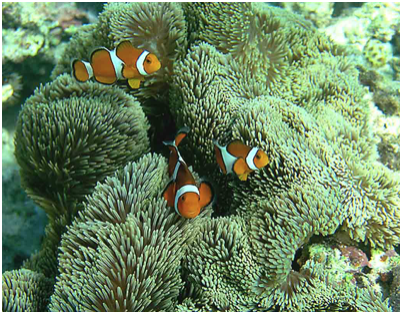
What Is a Community?
A community is the biotic part of an ecosystem. It consists of all the populations of all the species that live and interact in the ecosystem. It also includes their relationships with each other. All organisms in an ecosystem are connected in one way or another. In fact, populations of different species generally interact in a complex web of relationships. Relationships between species in communities are important factors in natural selection and help shape the evolution of the interacting species. There are three major types of community relationships: symbiosis, predation, and competition.
Symbiosis
Symbiosis is a close relationship between two organisms of different species in which at least one of the organisms benefits. For the other organism, the relationship may be beneficial or harmful, or it may have no effect. There are three basic types of symbiosis: mutualism, commensalism, and parasitism.
Mutualism
Mutualism is a symbiotic relationship in which individuals from both species benefit. The relationship between clownfish and anemones described above is an example of mutualism. Pollination of plants by pollinators such as bees is another example, as shown in Figure \(\PageIndex{2}\). Pollinators collect pollen from flowers for food. In the process of gathering the pollen, they disperse some of the pollen to other flowers and pollinate them. Humans have a mutualistic relationship with many species of intestinal bacteria. The bacteria gain a safe home with lots of available nutrients. In return, the bacteria provide their human host with vitamins, help with digestion, protection from harmful bacteria, or other goods or services.
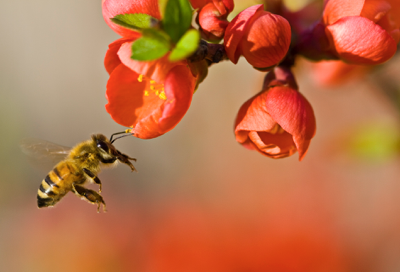
Commensalism
Commensalism is a symbiotic relationship in which an individual from one of the species benefits while an individual from the other species is unaffected. For example, some types of tiny insects called mites attach themselves to larger flying insects for transportation. The mites benefit from the free ride, and the larger insects are unaffected. Various biting lice and fleas feed harmlessly on the feathers of birds and on sloughed-off flakes of skin from mammals. Numerous birds (such as the cattle egret in Figure \(\PageIndex{3}\)) feed on insects and small mammals that are disturbed by large grazing mammals or a farmer’s plow. Plasmodium protists that cause human malaria and the mosquitoes that transmit them have a commensal relationship. The protists need the mosquitoes to get from one human host to another, but the mosquitoes are not affected by the protists.
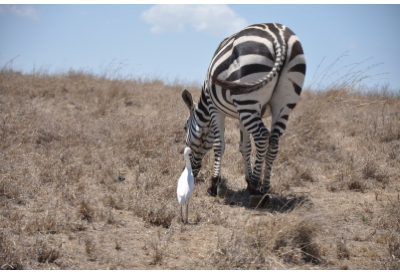
Parasitism
Parasitism is a symbiotic relationship in which an organism from one species, called the parasite, benefits, while an organism from the other species, called the host, is harmed. Many species of animals are parasites, at least during some stage of their life cycle. Most species are also hosts to one or more parasites. Some parasites live on the surface of their host. Others live inside their host. They may enter the host through a break in the skin or in food or water. For example, roundworms are parasites of mammals, including humans, cats, and dogs. Figure \(\PageIndex{4}\) shows adult roundworms clogging part of a human small intestine. The worms produce huge numbers of eggs, which are passed in the host’s feces to the environment. Other individuals may be infected by swallowing the eggs in contaminated food or water.
Some parasites kill their host. The roundworms in the human intestine in Figure \(\PageIndex{4}\) would most likely have killed their host were it not for surgical intervention. However, most parasites do not kill their host. It’s easy to understand why. If a parasite kills its host, the parasite is also likely to die. Instead, the majority of parasites cause relatively minor damage to their host.
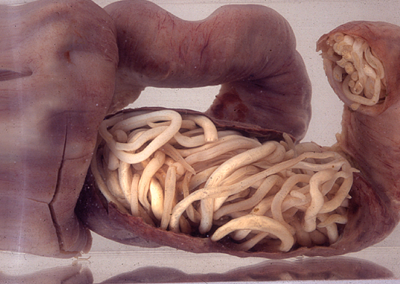
Predation
Predation is a community relationship in which organisms in one species, called the predator, consume tissues of organisms in another species, called the prey. Often this means killing the prey and eating all or most of the prey organism. You can see a graphic example of this in Figure \(\PageIndex{5}\). In this example, a snake is a predator and the prey is a large lizard. The snake is swallowing the live lizard whole. Prey species are not always killed by their predators. For example, many animals such as deer and cattle graze on plants without usually killing them. Another example of this type of predation is a mosquito feeding on a human organism’s blood.
Predators are often prey on their own. For example, blue jays prey on insects and may, in turn, be preyed upon by snakes. Snakes may also have predators, such as hawks. Examples of the few predators that are not also prey include sperm whales, tigers, and crocodiles.
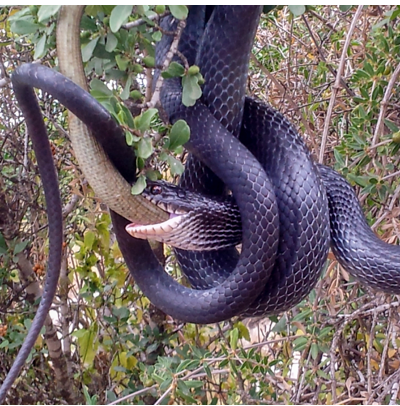
Predator-Prey Population Dynamics
A predator-prey relationship tends to keep the populations of both species in balance. Each population is a limiting factor on the other population. This is shown in the graph in Figure \(\PageIndex{6}\). As the prey population increases, there is more food for predators. Therefore, after a slight lag time, the predator population increases as well. As the number of predators increases, more prey is captured. As a result, the prey population starts to decrease. Then, as fewer prey become available, the predator population declines as well. This type of interaction might continue indefinitely.
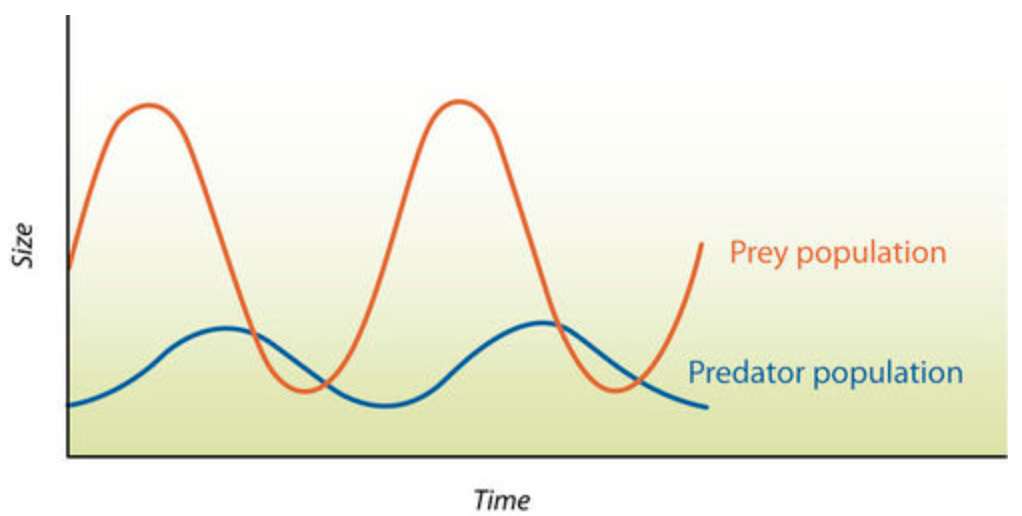
Adaptations to Predation
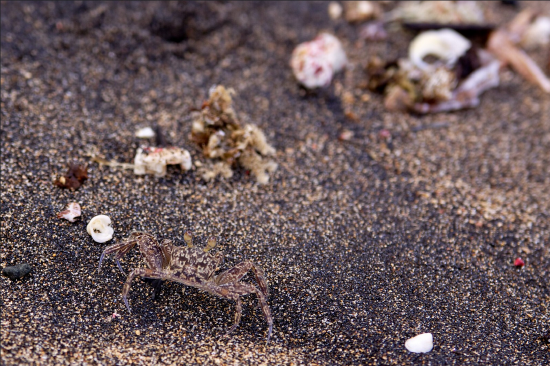
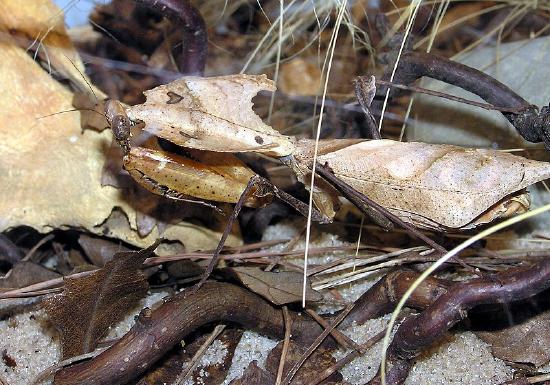
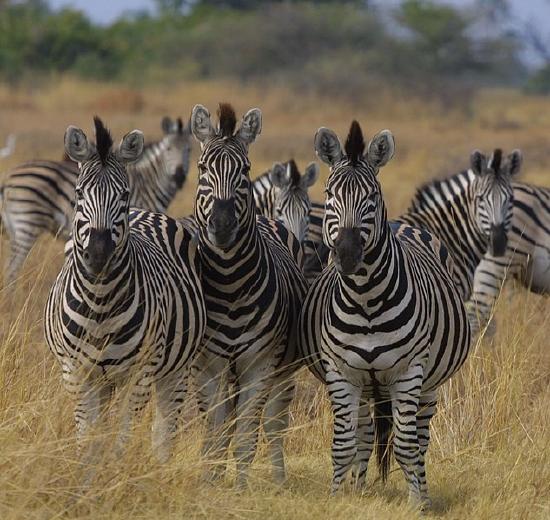
Both predators and prey are likely to have adaptations to predation that evolve through natural selection. Predator adaptations help them capture prey, whereas prey adaptations help them avoid predators. A common adaptation in both predators and prey is camouflage. Several examples are shown in Figure \(\PageIndex{7}\). Camouflage in prey helps them hide from their predators. Camouflage in predators helps them sneak up on or entrap their prey.
Interspecific Competition
Interspecific competition is a community relationship in which organisms from different species rely on the same limiting resource in their ecosystem. The resource might be food, water, sunlight, or space, among others.
Outcomes of Interspecific Competition
Interspecific competition is the basis of the competitive exclusion principle, which states that two different species cannot occupy the same niche in the same place for very long. Interspecific competition is likely to have one of two possible evolutionary outcomes: extinction of one species or the evolution of greater specialization in both species.
Interspecific competition often leads to extinction. The species that is less well adapted may get fewer of the limiting resource that both species need. As a result, members of that species are less likely to survive, and the species may go extinct.
Instead of extinction, interspecific competition sometimes leads to greater specialization in both species. Specialization occurs when competing species evolve different adaptations. For example, they may evolve adaptations that allow them to use different food sources or to obtain food at different times of the day. Figure \(\PageIndex{8}\) illustrates an example of this outcome of interspecific competition.
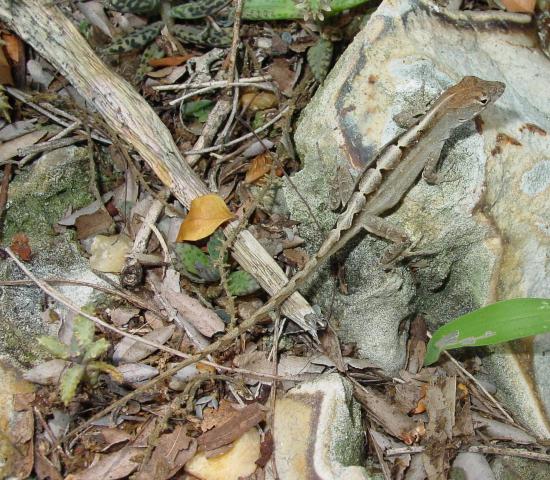
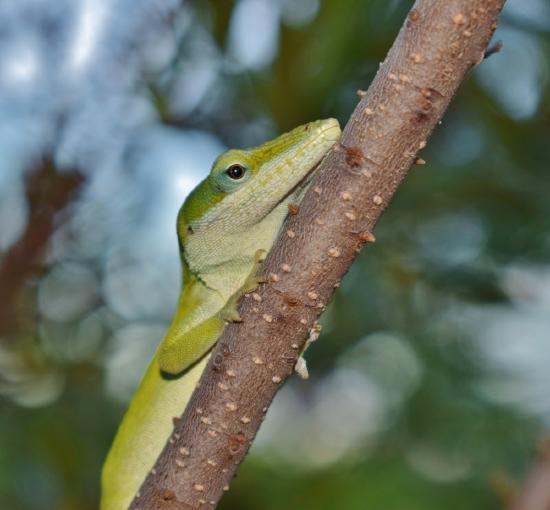
Feature: Human Biology in the News
Schistosomiasis is a neglected tropical disease that affects millions of people worldwide and causes thousands of deaths each year. It is caused by parasitic flatworms called schistosomes. The disease is spread by contact with fresh water that is contaminated with the larval stage of the parasites. The parasite larvae are released into the water by infected freshwater snails, which are also hosts of the parasites. Infection occurs when the tiny larvae penetrate human skin.
After schistosome larvae gain entrance to the human body, they develop into adult worms in their host’s veins. Female adults release eggs inside the human host. Some of the eggs may become trapped in body tissues, causing an immune reaction and major damage to internal organs. Other eggs pass out of the human host through urine or feces. If the eggs enter a body of water and infect freshwater snails, the cycle of transmission and human infection is likely to be repeated. Schistosomiasis is especially common among children in developing countries (like the child in Figure \(\PageIndex{9}\)) because they are more likely to play in contaminated water. Other high-risk groups include farmers, fishermen, and people who must use contaminated water for household purposes.
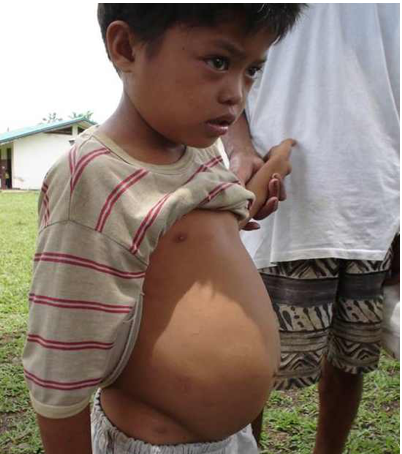
Although drugs are available to cure schistosomiasis, most people who have been infected and cured are likely to be reinfected because of continued unavoidable contact with contaminated water. Researchers are trying to develop a vaccine to prevent transmission of the parasites but so far without success. That’s where a bioengineer at Stanford University comes in. Professor Manu Prakash has been studying schistosome parasites with novel approaches to understand how the parasites move through the water to infect human hosts.
At the end of 2016, Professor Prakash published preliminary results of his research. He found that schistosome larvae have a completely unique way of swimming. The larvae have a forked tail that they hold perpendicular to their body while they swim against gravity to reach water near the surface. Using mathematical modeling and robotics, Professor Prakash was able to show that this particular swimming technique is the optimal way for the larvae to quickly reach surface water where they are most likely to encounter a human being to infect. Schistosome larvae have no feeding organs, so they must find a human host within about 12 hours or they will die. Professor Prakash hopes that the detailed understanding of how the parasites swim may lead to a way to slow them down so they cannot reach and infect a human host within this 12-hour window.
Review
- In the context of the ecosystem, what is a community?
- Identify the three major types of community relationships.
- What is symbiosis?
- Name three different types of symbiosis.
- Define mutualism and describe an example.
- Why is the relationship between cattle egrets and grazing mammals an example of commensalism?
- Define parasitism and give an example.
- What is predation, and what is an example of predation?
- Explain the relationship between predator and prey populations.
- How can predators and prey influence each other’s evolution?
- What is an interspecific competition?
- What are two possible outcomes of interspecific competition?
- True or False. In a symbiotic relationship, the two species have to physically touch each other.
- True or False. The relationship between the protists that cause human malaria and humans is an example of commensalism.
Explore More
Watch this video to learn about biodiversity
Attributions
- Amphiprion ocellaris by Michael arvedlund, public domain via Wikimedia Commons
- Pollination by Louise Docker, licensed CC BY 2.0 via Wikimedia Commons
- Cattle egrets by Jorge Láscar, licensed CC BY 2.0 via Wikimedia Commons
- Intestine blocked by worms by SuSanA Secretariat, licensed CC BY 2.0 via Wikimedia Commons
- Dolichophis jugularis by yigal gini, licensed CC BY 2.5 via Wikimedia Commons
- Predator-prey graph by Hana Zavadska via CK-12 licensed CC BY-NC 3.0
- Camouflage by Thomas Hubauer, licensed CC BY 2.0 via Flickr
- Dead leaf mantis by Adrian Pingstone, public domain via Wikimedia Commons
- Zebra Botswana by Paul Maritz, CC BY-SA 3.0 via Wikimedia Common
- Brown Anole by pondhawk, CC BY 2.0 via Flickr
- Schistosomiasis in a child by SuSanA Secretariat, licensed CC BY 2.0 via Wikimedia Commons
- Text adapted from Human Biology by CK-12 licensed CC BY-NC 3.0


